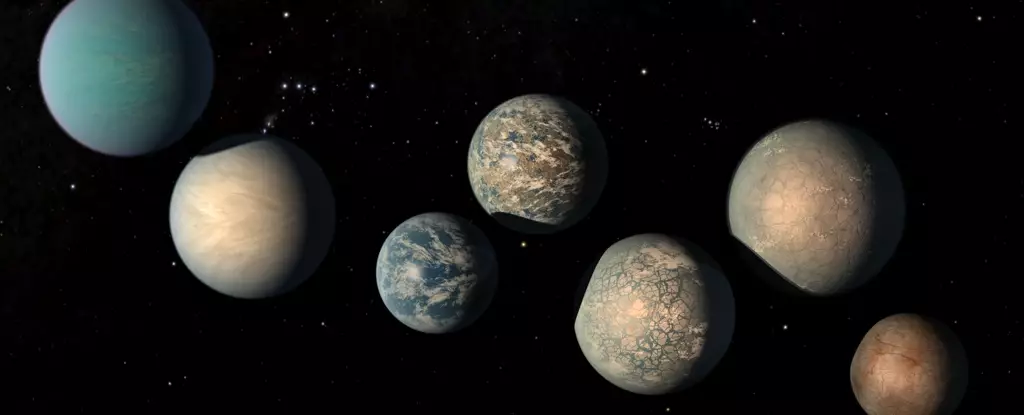In the vast cosmos, where darkness abounds, the discovery of the TRAPPIST-1 system—located approximately 40 light-years away—has ignited interests within the scientific community. First identified in February 2017, this extraordinary solar system consists of seven planets orbiting a red dwarf star, known for its peculiar properties. As astronomers continue to scrutinize these celestial bodies, questions surrounding their potential for harboring life lead to a compelling discussion about habitability and the presence of water.
The TRAPPIST-1 system shares similarities with our Solar System but differs substantially in its stellar characteristics, orbit dynamics, and planetary composition. The central star is an M-type dwarf, smaller and cooler than our Sun, which raises intrigue but also challenges as red dwarfs have been notorious for their active flares and intense radiation. The ability of planets orbiting such a star to retain essential elements, like water, has been a focal point of intense research and speculation.
The Water Paradox
Water is undeniably a keystone in the search for extraterrestrial life. The quest to discover whether TRAPPIST-1’s planets might be “water worlds”—teeming with oceans or possibly frozen landscapes—has led researchers to examine the dynamics of water retention in these environments. While initial studies hinted at a potential overabundance of water, subsequent analyses raised red flags about its sustainability.
High energy ultraviolet radiation from red dwarf stars, including TRAPPIST-1, often leads to significant water loss into space. Recent findings suggest that, despite indications of water sources, any water vapor present may rapidly dissipate under the harsh conditions dictated by the system’s stellar dynamics. Astrobiologist Trent Thomas and his team have ventured deeper into these findings, developing a theoretical model that seeks to clarify the relationship between water presence and volcanic activity among these planets.
New Research Brings Hope
Recent observations from the James Webb Space Telescope (JWST) turned the spotlight on TRAPPIST-1 c, illuminating the complexities of its atmospheric composition. The research dispelled notions of a thick carbon dioxide atmosphere, which could have previously painted the planet as akin to Venus, widely deemed inhospitable. However, this revelation opens new avenues: the possibility of water vapor and oxygen production through chemical dissociation remains plausible, ushering in questions about volcanic outgassing—a process essential for sustaining water vapor indefinitely.
The advanced model generated by Thomas’ team draws comparisons with known rocky planets, such as Earth, Mars, Venus, and Mercury, to argue that the outgassing of water could range significantly. While they indicated the potential for relatively dry environments on TRAPPIST-1 planets, the possibility of outgassing rates exponentially exceeding those on Earth fuels excitement rather than despair.
The Implications of Volcanic Activity
The volcanic activity standing in the balance is a central theme in this ongoing investigation. The modeling study posits that outgassing rates may be lower than Earth’s but could vary enough to signal latent volcanic activity. This leads to an intriguing concept: potentially “dead” planets may still harbor secrets hidden beneath their surfaces. If the planets maintain regions of magma like Mars, albeit dormant, they could still offer a glimmer of hope in the search for life.
The researchers propose that the planets could exhibit dry mantles, even though they entertain the possibility that water might compose up to 1 percent of their mass. This insight draws parallels to Earth itself, which has vast oceans despite constituting a mere fraction of its overall mass. The TRAPPIST-1 planets reveal a fascinating duality: they could range from barren landscapes to Earth-like settings rich in water.
Future Prospects and Research
With ongoing observations from instruments like the JWST, the quest for understanding the TRAPPIST-1 system is just beginning. The current research, while illuminating, also underscores the expansive frontier of knowledge that remains uncharted. As understanding improves, scientists will tighten the focus on the habitability of these intriguing worlds.
Engaging in these types of studies, scientists are not merely unveiling data; they are piecing together an evolving narrative that may one day offer insight into life beyond Earth. In the realm of exoplanet exploration, the TRAPPIST-1 system stands as a testament to the possibilities that lie beyond our own planet, truly reinforcing the idea that we are but a speck in a universe filled with potential.


Leave a Reply